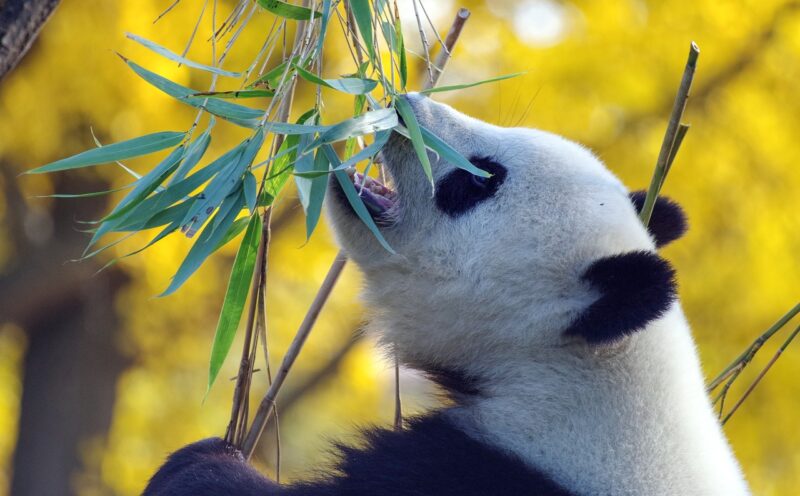The Fascinating Life of Giant Pandas: How They Live, Eat, and Thrive in the Wild
November 16, 2024

Giant pandas, known for their cute appearance and gentle demeanor, are one of the most beloved and distinctive animals in the world. These creatures have a rich history, unique characteristics, and an important role in their ecosystem. In this article, we will explore the lives of giant pandas, from their habitat and diet to their social behavior and conservation efforts, providing a holistic view of these incredible animals.
1. Introduction to Giant Pandas
Giant pandas (Ailuropoda melanoleuca), native to the mountainous regions of central China, are classified as a bear species. Their striking black and white coat makes them easily recognizable; however, their appearance is not the only characteristic that draws interest. Pandas have a fascinating lifestyle that contributes to their survival and the ecology of their habitat.
2. Habitat and Distribution
Giant pandas primarily inhabit the bamboo forests of the Sichuan, Shaanxi, and Gansu provinces of China. They prefer elevations between 1,200 to 3,300 meters (4,000 to 10,800 feet) where the environment provides plenty of bamboo, their primary food source. Unfortunately, habitat degradation and fragmentation have put significant pressure on their populations.
Bamboo forests, crucial for panda survival, are threatened by climate change and human activities such as logging and agriculture. As these forests diminish, so does the panda’s habitat, impacting their ability to thrive in the wild.
3. Diet: The Bamboo Connection
Despite being classified as carnivores, giant pandas have adapted to a mostly herbivorous diet consisting of 99% bamboo. They consume various species, depending on availability, which can include:
- Moso Bamboo: Known for its rapid growth, it offers high nutritional content for the pandas.
- Fargesia Bamboo: This type grows in dense clumps, providing ample food and shelter.
- Other Vegetation: Occasionally, pandas may eat fruits, vegetables, and small animals, but this is rare in the wild.
Giant pandas consume an astonishing amount of bamboo each day, averaging between 26 to 84 pounds (12 to 38 kilograms). Due to the low nutritional content of bamboo, they spend up to 12 hours a day eating to meet their energy needs. This enormous dietary requirement is a significant aspect of their lifestyle and survival.
4. Social Behavior and Reproduction
Giant pandas are generally solitary creatures. Adult pandas have distinct territories, which they mark by leaving scent marks on trees and rocks. Males and females only come together during the breeding season, which is typically from March to May. This brief period of courtship and mating is critical, as females are fertile only for a few days each year.
The gestation period for giant pandas lasts about 95 to 160 days and often results in one or two cubs being born. However, in the wild, mothers typically raise only one cub, as they require extensive attention and resources. The survival rate for panda cubs is relatively low, with factors such as predation and environmental conditions affecting their chances. When born, they are entirely helpless, weighing about 3 to 5 ounces (85 to 140 grams), and depend on their mother’s milk for nourishment.
5. Conservation Efforts
Giant pandas are classified as vulnerable by the International Union for Conservation of Nature (IUCN). Conservation efforts have focused on habitat preservation, restoration, and public awareness campaigns. Some of the notable initiatives include:
- Nature Reserves: The establishment of panda reserves has been crucial in protecting their habitats from deforestation and encroachment.
- Captive Breeding Programs: Zoos and conservation groups participate in breeding programs to increase the population and reintroduce pandas into the wild.
- Research & Monitoring: Ongoing research and monitoring of panda populations help understand their behaviors and adapt conservation strategies accordingly.
The combination of habitat protection and captive breeding has shown positive results, with the giant panda population gradually increasing over recent years. In 2016, the IUCN reclassified the species from endangered to vulnerable, marking a significant success in conservation efforts.
6. The Role of Pandas in Their Ecosystem
Giant pandas play a vital role in their ecosystem. As herbivores, they help maintain bamboo forests by promoting healthy growth. Their feeding habits create openings in the forest, allowing sunlight to reach the forest floor, which supports the growth of other plant species. Thus, they contribute to the overall biodiversity of their habitats.
Moreover, pandas are also a symbol of wildlife conservation globally. Their popularity raises awareness for conservation efforts, not only for pandas but also for numerous other endangered species and their habitats.
7. Conclusion
The giant panda is a remarkable species with a unique lifestyle shaped by the challenges of its environment. From their bamboo diet to their solitary nature, pandas continue to capture the hearts of people around the world. As we learn more about these enchanting creatures, it becomes imperative to focus our efforts on their conservation to ensure they thrive for generations to come. Protecting giant pandas means protecting their homes, maintaining biodiversity, and supporting a globally significant symbol of conservation. Let’s work together to secure a future where giant pandas continue to roam the bamboo forests of China, inspiring us all in the process.








